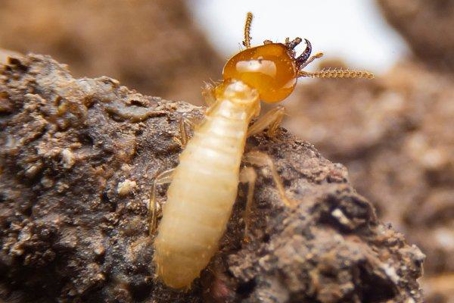We don’t want to scare you, but we do want to keep you in the loop: South Carolina has a termite problem, and it isn’t going to go away any time soon. Termites range far and wide in our beloved state, thanks to high humidity levels, warmer seasonal temperatures, and a whole lot of wooden objects (hint: it’s your house). Termites love living here in the Palmetto State, and the environment loves having them around, too! While it might be a little hard to believe, termites are awesome helpers in the food chain by breaking down glucose and cellulose layers, disposing of rotten wood, and generally creating more soluble nutrients for plants and animals. For creatures living in the ecological circle of life, termite is an amazing part of daily life.
As human beings, we are not quite as involved in the said ecological circle as other mammals are. We are likely to be less-than-pleased when we spot an insect that looks:
- Yellow, tan, or cream-colored in appearance
- Has a large head and enormous mandibles
- Is similar to an ant without the short thorax section
If you spot a bug that looks all too similar to these characteristics, you likely have a wood-eating termite colony on your property. Termites cause a jaw-dropping five billion dollars of damage in households worldwide. Here in South Carolina, they generate several million dollars worth of damage every year. The termite's ability to chew through wooden supports, beams, and housing materials is well known to most residents, but spotting signs of their appearance is much harder than it looks. Let’s explore why annual termite inspections are so important to homeowners in South Carolina.
Ways To Spot A South Carolina Termite Problem
It can be surprisingly difficult to spot a termite problem in the home, especially in the initial stages. This is largely due to the secretive nature and quiet behavior of termite species. Termites may emanate a soft clicking down from the walls or create mud tunnels that run up and down the sides of buildings, but these symptoms only become apparent after the infestation has become too large to handle. Once this point has been passed, homeowners insurance will likely refuse to cover damages due to preexisting or preventable conditions. This sobering truth is one of the many reasons why keeping an eye out for termite activity is incredibly important. Here are a few ways to spot termites during the early stages of infestation:
- Light or fine sawdust piles created near the sides of the home (frass)
- Tight-fitting doors and windows that seem not to open or close properly
- Spotting flying termites, known as alates or swarmers, around the property
- Finding shed alate wings inside of the home
Have your home checked for the subtle signs of termite infestation with a home inspection from The Original Bugman Pest Elimination, Inc. today.
Terrorized Of Termites? Take Back What’s Yours With The Original Bugman Pest Elimination, Inc.
Annual termite inspections are important, and who better to lend a hand than the professional team at The Original Bugman Pest Elimination, Inc. Our teams are always on call to deliver an outstanding inspection and treatment experience in any home or environment. We mean business against termites, and have exactly what it takes to root them out for good!
If termites come calling this spring, it won’t be wise to look for solutions alone. Protect your valuable time and money by calling the experts at The Original Bugman Pest Elimination, Inc. right away!
Schedule Your Free Inspection
Complete the form below to schedule your no-obligation inspection.

